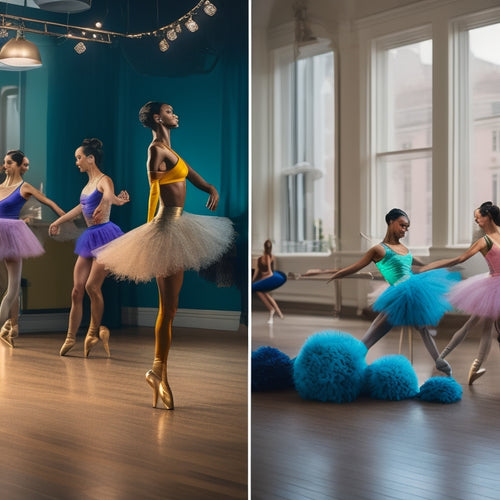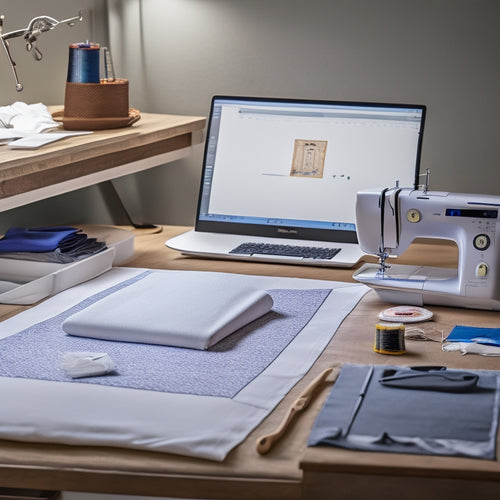
Savvy Choreography Templates for Middle Eastern Movement
Share
You're about to master savvy choreography templates for Middle Eastern movement by combining essential elements of belly dance, crafting compelling storylines, and balancing complexity and simplicity. Identify and master fundamental movement phrases, then use them as building blocks for dance continuity. Weave these elements together to create engaging performances that honor cultural significance. As you explore Middle Eastern rhythms, refine your stage presence, and adapt choreography for performance, you'll reveal the secrets to creating enchanting dance storylines - and discover how to elevate your performances to the next level.
Key Takeaways
• Master fundamental elements, including posture, alignment, isolations, footwork, and musicality, to create a strong technical base for dance expression.
• Develop a compelling dance storyline by weaving fundamental elements into a narrative, utilizing dance archetypes, and applying storyboard secrets.
• Construct choreography by identifying and mastering fundamental movement phrases, using them as building blocks, and focusing on musicality foundations.
• Explore and incorporate Middle Eastern rhythms, mastering complex time signatures and polyrhythms, to create choreography that honors cultural significance.
• Balance complexity and simplicity by breaking down complex movements, focusing on proper technique and alignment, and providing clear instructions and demonstrations.
Essential Elements of Belly Dance
You'll build a strong foundation in belly dance by mastering the five essential elements: posture, alignment, isolations, footwork, and musicality, which form the core of this ancient art form.
As you explore these fundamental components, you'll develop a strong technical base that will enhance your overall dance expression.
Costume considerations play an important role in your performance, as the right attire can accentuate your movements and add to the overall aesthetic. When selecting a costume, prioritize comfort and mobility, ensuring that your attire doesn't restrict your movements.
Now, let's immerse ourselves in musicality fundamentals, which involve understanding the rhythm, melody, and tempo of the music. This understanding will enable you to execute movements that harmonize with the music, creating an engaging performance.
Crafting Engaging Dance Storylines
Having mastered the fundamental elements of belly dance, it's time to weave them into a compelling narrative, crafting a dance storyline that resonates with your audience. This is where dance archetypes come into play. By tapping into universal themes and character archetypes, you can create a narrative that resonates with your audience on a deeper level. Think of the Siren, the Seductress, or the Mystic - each archetype evokes a distinct energy and emotional response.
To craft a cohesive storyline, try using storyboard secrets. Break down your dance into scenes or sections, and map out the emotional arc of your narrative. This will help you visualize the flow of your dance and guarantee a clear beginning, middle, and end.
Consider the emotional tone of each section and how it contributes to the overall narrative. By combining dance archetypes with storyboard secrets, you'll be well on your way to crafting an engaging dance storyline that leaves a lasting impact on your audience. With practice and patience, you'll be weaving together a narrative that's both authentic and enthralling.
Building Blocks of Choreography
Your choreography template begins to take shape with the identification and mastery of fundamental movement phrases, which serve as the building blocks of your dance. These phrases, often comprising 3-5 movements, form the foundation of your choreography, providing a sense of continuity and cohesion.
By mastering these building blocks, you'll gain creative freedom to experiment with different combinations, connections, and variations, ultimately enhancing your overall dance narrative.
When constructing your movement phrases, focus on developing musicality foundations by paying attention to timing, phrasing, and dynamics. This will enable you to create a harmonious relationship between movement and music, resulting in a more engaging and polished performance.
Exploring Middle Eastern Rhythms
Mastering Middle Eastern rhythms, which often feature complex time signatures and polyrhythms, is vital for creating an authentic and enchanting dance performance. As you explore the world of Middle Eastern rhythms, you'll uncover a rich tapestry of cultural significance woven into the fabric of each rhythmic pattern. Understanding these rhythms is essential for conveying the emotional depth and nuances of Middle Eastern dance.
When investigating Middle Eastern rhythms, pay attention to the intricate patterns and time signatures that define each style. For instance, the traditional Turkish rhythm, Karsilama, features a 9/8 time signature, while the Arabic rhythm, Maqsum, is characterized by a 4/4 time signature with an emphasis on the second beat. Recognizing these rhythmic patterns will enable you to create choreography that not only showcases technical proficiency but also honors the cultural significance of the dance.
As you build your knowledge of Middle Eastern rhythms, you'll develop a deeper appreciation for the cultural context in which they evolved. By incorporating these rhythms into your choreography, you'll create a performance that not only dazzles the audience with its technical complexity but also resonates with the cultural significance of the dance.
Seamless Transitions and Links
You'll need to carefully craft smooth connections and links between movements to create a cohesive, polished performance that flows effortlessly from one rhythmic pattern to the next.
Seamless progressions are key to a mesmerizing show, as they guide the audience's attention and create a sense of continuity. To achieve fluid connections, focus on smooth segues that bridge the gaps between movements.
This can be done by using transitional phrases, which are short sequences of movement that connect two distinct rhythms or patterns. These phrases should be choreographed to blend seamlessly with the preceding and following movements, ensuring a cohesive flow.
By doing so, you'll create an uninterrupted visual narrative that engages the audience from start to finish. To further enhance your transitions, experiment with varying dynamics, tempo, and spatial arrangements to add texture and depth to your performance.
Adding Emotional Depth to Movement
To infuse your Middle Eastern-inspired choreography with emotional resonance, explore the nuances of expressive movement, where subtle variations in gesture, posture, and facial expression can convey complex emotions and inner narratives. By mastering these subtleties, you'll create an authentic expression that resonates with your audience.
To deepen the emotional connection, focus on the following elements:
| Element | Description |
|---|---|
| Breathwork | Use controlled breathing to convey emotional intensity or relaxation |
| Facial Expressions | Subtly shift between emotions through nuanced facial cues |
| Postural Adjustments | Convey confidence, vulnerability, or playfulness through deliberate posture changes |
| Gesture Language | Employ culturally-specific gestures to convey emotional authenticity |
Customizing Choreography for Students
When customizing choreography for your students, you'll want to take into account their individual learning styles, as some may respond better to visual cues, while others may require more kinesthetic guidance.
You'll also need to evaluate their dance experience levels, as beginners may require more breakdowns of complex movements, whereas advanced students can handle more intricate sequences.
Student Learning Styles
By recognizing and accommodating individual learning styles, instructors can adapt their choreography to maximize student understanding and retention of Middle Eastern movement techniques.
As a savvy instructor, you'll want to identify the dominant learning styles of your students, including Visual Learners, Auditory Learners, and Kinesthetic Learners.
Visual Learners, for instance, respond well to demonstrations, videos, and diagrams. You can create customized choreography templates with visual cues, such as arrows indicating direction or footwork patterns. This will help them internalize the movements and retain the choreography more effectively.
Students with strong Kinesthetic Intelligences, on the other hand, learn best through hands-on experience and tactile feedback. You can incorporate exercises that focus on subtle weight transfers, body isolations, or intricate hand movements, allowing them to develop muscle memory and master the techniques.
Dance Experience Levels
You'll need to tailor your choreography to accommodate students with varying levels of dance experience, from absolute beginners to advanced dancers, to guarantee that each student receives an ideal learning experience. This customization is important, as beginner struggles can lead to frustration and injury if not addressed properly.
As you design your choreography, consider the needs of your students at each level. For beginners, break down complex movements into manageable parts, focusing on proper technique and alignment. Provide clear instructions and demonstrations to make sure they grasp each step before moving forward.
For intermediate dancers, introduce more complex movements and layering, gradually increasing the intensity and speed of the choreography. Advanced dancers, on the other hand, will have high expectations for challenging and intricate movements. Be prepared to push them beyond their comfort zones while still maintaining a safe and controlled environment.
Balancing Complexity and Simplicity
As you design choreography for Middle Eastern movement, striking a balance between complexity and simplicity becomes vital to engaging your audience and conveying the nuances of this intricate dance style.
You must carefully consider how to balance intricate footwork, arm movements, and body isolations to create a visually appealing performance. To achieve this balance, it's essential to establish a clear visual hierarchy, guiding the audience's attention to the most critical elements of the dance.
This can be achieved by varying the tempo, dynamics, and spatial arrangements of the dancers.
Effective Use of Musical Phrasing
When crafting choreography for Middle Eastern dance, you'll frequently find that the effective use of musical phrasing is key to creating a compelling performance that resonates with your audience. By understanding the intricacies of the music, you can create a harmonious relationship between movement and melody.
One essential aspect of musical phrasing is Rhythmic Accentuation, which involves emphasizing specific beats or rhythms to add texture and dynamics to your choreography. This can be achieved through subtle arm movements, hip accents, or even floorwork patterns that mirror the rhythmic pulse of the music.
To take your choreography to the next level, consider Melodic Interpretation, where you translate the melodic lines into movement phrases. This can be done by mirroring the contour of the melody with your arm movements or using the melody's emotional intensity to inform your facial expressions or gestures.
Adapting Templates for Performance
As you prepare to adapt your choreography templates for performance, you'll need to focus on refining your stage presence and considering the cultural nuances that make your Middle Eastern-inspired dance authentic.
You'll want to guarantee your performance exudes confidence and charisma, while also honoring the rich cultural heritage that informs your movement. By balancing these essential elements, you'll create a mesmerizing performance that resonates with your audience.
Stage Presence Essentials
Developing a strong stage presence requires intentional adaptation of your choreography templates to engage your audience and convey the emotional intensity of Middle Eastern movement.
As you take the stage, you'll want to focus on confidence building exercises to calm your nerves and connect with the audience. Practice positive self-talk, visualize your success, and physically prepare your body through stretching and warm-ups. This confidence will translate into an authentic connection with your audience, allowing them to resonate with your performance.
To establish this connection, focus on maintaining eye contact, varying your facial expressions, and using intentional gestures. These non-verbal cues will help convey the emotional intensity of the Middle Eastern movement, drawing the audience into the performance.
Additionally, experiment with dynamic spatial awareness, using the stage to create a sense of drama and tension. By combining these elements, you'll create an engaging stage presence that will leave a lasting impression on your audience.
Cultural Nuances Matter
You'll need to adapt your choreography templates to honor the cultural nuances of Middle Eastern movement, ensuring that your performance is respectful, authentic, and engaging.
As you explore the world of Middle Eastern dance, it's important to prioritize respectful representation and cultural ownership. This means being mindful of the cultural context and historical significance of the movements you're performing.
To achieve this, research and consult with experts from the Middle Eastern community to gain a deeper understanding of the cultural nuances and symbolism behind each movement. Be cautious of cultural appropriation and avoid reducing complex cultural practices to superficial gestures.
Instead, focus on creating an authentic and respectful representation that honors the cultural heritage of the region.
Frequently Asked Questions
Can I Use These Templates for Other Dance Styles Besides Belly Dance?
You're wondering if these templates are limited to belly dance? Absolutely not! You can adapt them to explore fusion possibilities, leveraging cross-training benefits to enhance your skills in various dance styles while ensuring a safe, controlled learning environment.
How Do I Handle Students With Varying Levels of Dance Experience?
When teaching diverse students, you'll encounter a mix of beginners and seasoned dancers; to foster Dance Inclusivity and accommodate Mixed Abilities, you'll need to modify choreography, provide options, and offer personalized feedback to guarantee a safe, engaging experience.
Can I Modify Templates to Fit a Specific Music Style or Genre?
You can adapt templates to fit specific music styles or genres by applying Genre Adaptation techniques, fusing different Style Fusions to create unique choreography that suits your students' diverse needs and guarantees a safe, engaging learning environment.
Are These Templates Suitable for Solo or Group Performances?
'When in doubt, practice makes perfect. You'll find these templates adaptable to both solo and group performances, allowing you to experiment with dynamic Dance Formations and Performance Dynamics, ensuring an engaging show that prioritizes your safety and artistry.'
Do I Need Prior Choreography Experience to Use These Templates?
You don't need prior choreography experience to use these templates; however, having some familiarity with templates will reduce choreography anxiety, enabling you to focus on mastering Middle Eastern movements with confidence and safety.
Related Posts
-

Best Dance Footwear for Comfort and Performance
When selecting the best dance footwear for comfort and performance, prioritize shoes with exceptional arch support an...
-

Revamp PDF Sewing Patterns With Copy Shop Ease
You can revamp your PDF sewing patterns to achieve copy shop ease by streamlining the conversion process and optimizi...
-

Tips and Tricks for Collapsible Ballet Bar Installation
To install your collapsible ballet bar, start by gathering essential tools like a drill, level, and measuring tape. M...


